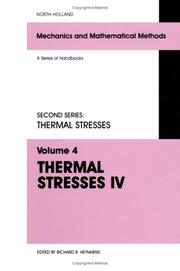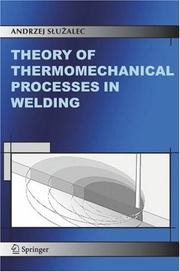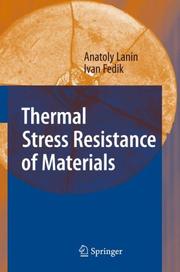| Listing 1 - 10 of 10 |
Sort by
|

ISBN: 1281059900 9786611059903 0080542816 9780080542812 9780444815712 0444815716 Year: 1996 Publisher: Amsterdam ; New York : New York : North-Holland ; Sole distributors for the U.S.A. and Canada, Elsevier Science Pub. Co.,
Abstract | Keywords | Export | Availability | Bookmark
 Loading...
Loading...Choose an application
- Reference Manager
- EndNote
- RefWorks (Direct export to RefWorks)
This is the fourth volume of the handbook Thermal Stresses. Following the principles established when the first volume was published in 1986, the fourth volume consists of six separate chapters prepared by specialists in the field. Each chapter is devoted to a different topic in the area of Thermal Stresses. Many results have been published for the first time in Thermal Stresses IV. The exposition of the material is on the state-of-the art level, which should be appropriate for graduate students, researchers, and engineers specializing in the field of stress analysis. In most cas
Thermal stresses. --- Thermal-expansion stresses --- Expansion (Heat) --- Expansion of solids --- Strains and stresses --- Thermoelasticity
Book
ISBN: 163485389X 9781634853897 9781634853736 1634853733 9781634853897 Year: 2016 Publisher: New York : Nova Publishers,
Abstract | Keywords | Export | Availability | Bookmark
 Loading...
Loading...Choose an application
- Reference Manager
- EndNote
- RefWorks (Direct export to RefWorks)
Thermal stresses. --- Thermal-expansion stresses --- Expansion (Heat) --- Expansion of solids --- Strains and stresses --- Thermoelasticity
Periodical
Abstract | Keywords | Export | Availability | Bookmark
 Loading...
Loading...Choose an application
- Reference Manager
- EndNote
- RefWorks (Direct export to RefWorks)
Thermal stresses --- Thermal-expansion stresses --- Chemistry --- Engineering --- Mathematical Sciences --- Physics --- Analytical Chemistry --- Inorganic Chemistry --- Kinetics --- Civil Engineering --- Applied Mathematics --- Thermodynamics and Heat Transfer --- Expansion (Heat) --- Expansion of solids --- Strains and stresses --- Thermoelasticity
Book
ISBN: 1634853792 9781634853798 9781634853675 1634853679 Year: 2016 Publisher: Hauppauge, New York, USA : Nova Science Publishers Incorporated,
Abstract | Keywords | Export | Availability | Bookmark
 Loading...
Loading...Choose an application
- Reference Manager
- EndNote
- RefWorks (Direct export to RefWorks)
Pressure vessels --- Thermal stresses. --- Heat --- Heat transfer --- Thermal transfer --- Transmission of heat --- Energy transfer --- Thermal-expansion stresses --- Expansion (Heat) --- Expansion of solids --- Strains and stresses --- Thermoelasticity --- Containers, Pressurized --- Pressurized containers --- Containers --- High pressure (Science) --- Autoclaves --- Boilers --- Caissons --- Compressed air --- Steam-boilers --- Tanks --- Testing. --- Transmission.
Book
ISBN: 1402092466 1402092474 Year: 2009 Publisher: [Dordrecht?] : Springer,
Abstract | Keywords | Export | Availability | Bookmark
 Loading...
Loading...Choose an application
- Reference Manager
- EndNote
- RefWorks (Direct export to RefWorks)
This book is intended as an advanced modern textbook and reference handbook on the topic of thermal stresses. It should serve a wide range of readers, in particular, graduate and postgraduate students, scientists, researchers in various industrial and government institutes, and engineers working in mechanical, civil, and aerospace engineering. This volume covers diverse areas of applied mathematics, continuum mechanics, stress analysis, and mechanical design. This work treats a number of topics not presented in other books on thermal stresses, for example: theory of coupled and generalized thermoelasticity, finite and boundary element method in generalized thermoelasticity, thermal stresses in functionally graded structures, and thermal expansions of piping systems. As the field of thermal stresses lies at the crossroads of stress analysis, theory of elasticity, heat conduction, and advanced methods of applied mathematics, all these subjects are dealt with in the book to the extent they are necessary. Thus, the book is self-contained, so that the reader should not need to consult other sources while studying the topic. The book starts from basic concepts and principles, and these are developed to more advanced levels as the text progresses. Nevertheless, some basic knowledge on the part of the reader is expected in classical mechanics, stress analysis, and mathematics, including vector and cartesian tensor analysis. .
Thermal stresses --- Materials Science --- Civil Engineering --- Civil & Environmental Engineering --- Chemical & Materials Engineering --- Engineering & Applied Sciences --- Thermal stresses. --- Structural engineering. --- Engineering, Structural --- Structures, Engineering of --- Thermal-expansion stresses --- Engineering. --- Mechanics. --- Mechanics, Applied. --- Continuum mechanics. --- Structural mechanics. --- Mechanical engineering. --- Engineering design. --- Theoretical and Applied Mechanics. --- Continuum Mechanics and Mechanics of Materials. --- Structural Mechanics. --- Mechanical Engineering. --- Engineering Design. --- Architecture --- Engineering --- Expansion (Heat) --- Expansion of solids --- Strains and stresses --- Thermoelasticity

ISBN: 1402029918 1281066907 9786611066901 9048167620 140202990X Year: 2005 Publisher: Berlin : Springer,
Abstract | Keywords | Export | Availability | Bookmark
 Loading...
Loading...Choose an application
- Reference Manager
- EndNote
- RefWorks (Direct export to RefWorks)
This book presents a modern viewpoint of welding thermomechanics and provides a unified and systematic continuum approach for engineers and applied physicists working on the modelling of welding processes. The theory presented includes developments in the areas of welding thermodynamics, thermoplasticity and numerical methods. The book describes the calculation of thermal stresses in welding structures, the theory of heat conduction in welding, and the basic equations of thermoplasticity, then applies the concepts to solutions of thermoplasticity problems and to thermal stresses in arc welding, laser welding, spot welding, electroslag welding and friction welding.
Friction welding. --- Thermal stresses. --- Welded joints --- Thermomechanical properties. --- Welds --- Joints (Engineering) --- Welding --- Thermal-expansion stresses --- Expansion (Heat) --- Expansion of solids --- Strains and stresses --- Thermoelasticity --- Pressure welding --- Engineering. --- Materials. --- Surfaces (Physics). --- Mechanical engineering. --- Engineering, general. --- Metallic Materials. --- Characterization and Evaluation of Materials. --- Mechanical Engineering. --- Engineering, Mechanical --- Engineering --- Machinery --- Steam engineering --- Physics --- Surface chemistry --- Surfaces (Technology) --- Engineering materials --- Industrial materials --- Engineering design --- Manufacturing processes --- Construction --- Industrial arts --- Technology --- Materials --- Metals. --- Materials science. --- Material science --- Physical sciences --- Metallic elements --- Chemical elements --- Ores --- Metallurgy --- Soudage --- Thermomecanique
Book
ISBN: 3030104362 3030104354 Year: 2019 Publisher: Cham : Springer International Publishing : Imprint: Springer,
Abstract | Keywords | Export | Availability | Bookmark
 Loading...
Loading...Choose an application
- Reference Manager
- EndNote
- RefWorks (Direct export to RefWorks)
This is an advanced modern textbook on thermal stresses. It serves a wide range of readers, in particular, graduate and postgraduate students, scientists, researchers in various industrial and government institutes, and engineers working in mechanical, civil, and aerospace engineering. This volume covers diverse areas of applied mathematics, continuum mechanics, stress analysis, and mechanical design. This work treats a number of topics not presented in other books on thermal stresses, for example: theory of coupled and generalized thermoelasticity, finite and boundary element method in generalized thermoelasticity, thermal stresses in functionally graded structures, and thermal expansions of piping systems. The book starts from basic concepts and principles, and these are developed to more advanced levels as the text progresses. Nevertheless, some basic knowledge on the part of the reader is expected in classical mechanics, stress analysis, and mathematics, including vector and cartesian tensor analysis. This 2nd enhanced edition includes a new chapter on Thermally Induced Vibrations. The method of stiffness is added to Chapter 7. The variational principle for the Green-Lindsay and Green-Naghdi models have been added to Chapter 2 and equations of motion and compatibility equations in spherical coordinates to Chapter 3. Additional problems at the end of chapters were added. .
Mechanics. --- Mechanics, Applied. --- Mechanical engineering. --- Materials. --- Solid Mechanics. --- Mechanical Engineering. --- Classical Mechanics. --- Structural Materials. --- Engineering --- Engineering materials --- Industrial materials --- Engineering design --- Manufacturing processes --- Engineering, Mechanical --- Machinery --- Steam engineering --- Applied mechanics --- Engineering mathematics --- Classical mechanics --- Newtonian mechanics --- Physics --- Dynamics --- Quantum theory --- Materials --- Thermal stresses. --- Thermal-expansion stresses --- Expansion (Heat) --- Expansion of solids --- Strains and stresses --- Thermoelasticity --- Structural materials. --- Architectural materials --- Architecture --- Building --- Building supplies --- Buildings --- Construction materials --- Structural materials --- Building materials.

ISBN: 1281232009 9786611232009 3540714006 3540713999 3642090559 Year: 2008 Publisher: New York ; Berlin : Springer,
Abstract | Keywords | Export | Availability | Bookmark
 Loading...
Loading...Choose an application
- Reference Manager
- EndNote
- RefWorks (Direct export to RefWorks)
This book deals with the problem of a bearing capacity and fracture of thermally loaded materials. The treatise is based on extensive experimental and technological data of materials-development processes for high-temperature nuclear reactors and aerospace nuclear-rocket engines. New regularities and irregularities of fracture at various modes of local and combined thermal loading using electron-beam, induction and ionic-beam technique of heating, and also with traditional methods of measuring the thermal stress resistance are discussed. New criteria for the estimation of the bearing capacity of bodies in inhomogeneous fields of thermal and residual stresses are developed on the basis of fracture mechanics. Changes in the thermal stress resistance of carbides (ZrC, NbC, and SiC), graphite, Si3N4, Y2O3, Sc2O3 Al2O3 and single crystals of sapphire are considered. Possible technological methods for the improvement of thermal stress resistance are also presented.
Thermal stresses. --- Strains and stresses. --- Architectural engineering --- Engineering, Architectural --- Stresses and strains --- Architecture --- Elastic solids --- Flexure --- Mechanics --- Statics --- Structural analysis (Engineering) --- Deformations (Mechanics) --- Elasticity --- Engineering design --- Graphic statics --- Strength of materials --- Stress waves --- Structural design --- Thermal-expansion stresses --- Expansion (Heat) --- Expansion of solids --- Strains and stresses --- Thermoelasticity --- Mechanical engineering. --- Engineering. --- Mechanical Engineering. --- Engineering Thermodynamics, Heat and Mass Transfer. --- Engineering, general. --- Engineering, Mechanical --- Engineering --- Machinery --- Steam engineering --- Construction --- Industrial arts --- Technology --- Thermodynamics. --- Heat engineering. --- Heat transfer. --- Mass transfer. --- Mass transport (Physics) --- Thermodynamics --- Transport theory --- Heat transfer --- Thermal transfer --- Transmission of heat --- Energy transfer --- Heat --- Mechanical engineering --- Chemistry, Physical and theoretical --- Dynamics --- Physics --- Heat-engines --- Quantum theory
Book
ISBN: 9783319145808 3319145797 9783319145792 3319145800 Year: 2015 Publisher: Cham : Springer International Publishing : Imprint: Springer,
Abstract | Keywords | Export | Availability | Bookmark
 Loading...
Loading...Choose an application
- Reference Manager
- EndNote
- RefWorks (Direct export to RefWorks)
This Volume presents a unified approach to calculate the plane stress distribution of stress and strain in thin elastic/plastic discs subject to various loading conditions. There is a vast amount of literature on analytical and semi-analytical solutions for such discs obeying Tresca’s yield criterion and its associated flow rule. On the other hand, most of analytical and semi-analytical solutions for Mises yield criterion are based on the deformation theory of plasticity. A distinguished feature of the solutions given in the present volume is that the flow theory of plasticity and Mises yield criterion are adopted. The solutions are semi-analytical in the sense that numerical methods are only necessary to evaluate ordinary integrals and solve transcendental equations. The book shows that under certain conditions solutions based on the deformation and flow theories of plasticity coincide. All the solutions are illustrated with numerical examples. The goal of the book is to provide the reader with a vision and an insight into the problems of analysis and design of elastic/plastic discs. The limitations and the applicability of solutions are emphasized. The book is written for engineers, graduate students and researchers interested in the development of techniques for analysis and design of thin elastic/plastic discs.
Engineering. --- Continuum Mechanics and Mechanics of Materials. --- Characterization and Evaluation of Materials. --- Algebraic Topology. --- Algebraic topology. --- Materials. --- Surfaces (Physics). --- Ingénierie --- Topologie algébrique --- Matériaux --- Surfaces (Physique) --- Engineering & Applied Sciences --- Chemical & Materials Engineering --- Applied Mathematics --- Materials Science --- Plates (Engineering) --- Plastic analysis (Engineering) --- Thermal stresses. --- Thermal-expansion stresses --- Analysis, Plastic --- Limit analysis (Engineering) --- Plastic analysis (Theory of structures) --- Ultimate strength analysis --- Disks (Mechanics) --- Panels --- Structural plates --- Continuum mechanics. --- Materials science. --- Expansion (Heat) --- Expansion of solids --- Strains and stresses --- Thermoelasticity --- Structural analysis (Engineering) --- Elastic plates and shells --- Shells (Engineering) --- Mechanics. --- Mechanics, Applied. --- Solid Mechanics. --- Topology --- Physics --- Surface chemistry --- Surfaces (Technology) --- Applied mechanics --- Engineering, Mechanical --- Engineering mathematics --- Classical mechanics --- Newtonian mechanics --- Dynamics --- Quantum theory --- Material science --- Physical sciences
Book
ISBN: 9783319128771 3319128760 9783319128764 3319128779 Year: 2015 Publisher: Cham : Springer International Publishing : Imprint: Springer,
Abstract | Keywords | Export | Availability | Bookmark
 Loading...
Loading...Choose an application
- Reference Manager
- EndNote
- RefWorks (Direct export to RefWorks)
The book describes a systematic stochastic modeling approach for assessing thermal-fatigue crack-growth in mixing tees, based on the power spectral density of temperature fluctuation at the inner pipe surface. It shows the development of a frequency-temperature response function in the framework of single-input, single-output (SISO) methodology from random noise/signal theory under sinusoidal input. The frequency response of stress intensity factor (SIF) is obtained by a polynomial fitting procedure of thermal stress profiles at various instants of time. The method, which takes into account the variability of material properties, and has been implemented in a real-world application, estimates the probabilities of failure by considering a limit state function and Monte Carlo analysis, which are based on the proposed stochastic model. Written in a comprehensive and accessible style, this book presents a new and effective method for assessing thermal fatigue crack, and it is intended as a concise and practice-oriented guide for all undergraduate students, young scientists and researchers dealing with probabilistic assessment of structural integrity. .
Engineering. --- Continuum Mechanics and Mechanics of Materials. --- Industrial and Production Engineering. --- Nuclear Engineering. --- Structural Materials. --- Materials. --- Industrial engineering. --- Nuclear engineering. --- Ingénierie --- Matériaux --- Génie industriel --- Génie nucléaire --- Engineering & Applied Sciences --- Chemical & Materials Engineering --- Materials Science --- Applied Mathematics --- Thermal stresses. --- Stochastic models. --- Models, Stochastic --- Thermal-expansion stresses --- Continuum mechanics. --- Production engineering. --- Structural materials. --- Mathematical models --- Expansion (Heat) --- Expansion of solids --- Strains and stresses --- Thermoelasticity --- Mechanics. --- Mechanics, Applied. --- Solid Mechanics. --- Nuclear Energy. --- Engineering --- Engineering materials --- Industrial materials --- Engineering design --- Manufacturing processes --- Management engineering --- Simplification in industry --- Value analysis (Cost control) --- Applied mechanics --- Engineering, Mechanical --- Engineering mathematics --- Classical mechanics --- Newtonian mechanics --- Physics --- Dynamics --- Quantum theory --- Materials --- Nuclear energy. --- Architectural materials --- Architecture --- Building --- Building supplies --- Buildings --- Construction materials --- Structural materials --- Atomic energy --- Atomic power --- Energy, Atomic --- Energy, Nuclear --- Nuclear power --- Power, Atomic --- Power, Nuclear --- Force and energy --- Nuclear physics --- Power resources --- Nuclear engineering --- Nuclear facilities --- Nuclear power plants --- Manufacturing engineering --- Process engineering --- Industrial engineering --- Mechanical engineering --- Building materials.
| Listing 1 - 10 of 10 |
Sort by
|

 Search
Search Feedback
Feedback About UniCat
About UniCat  Help
Help News
News